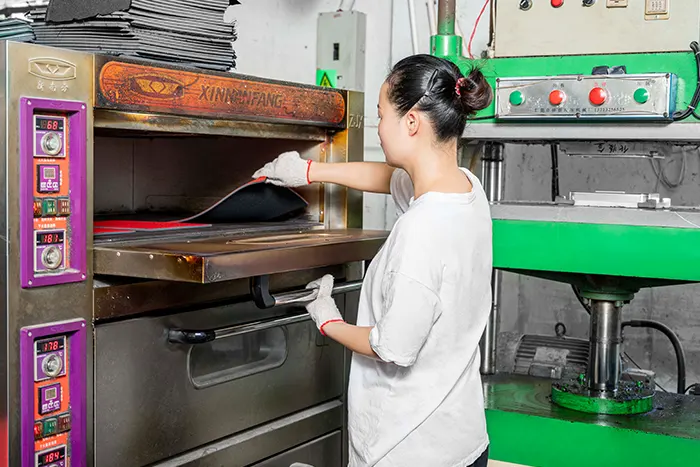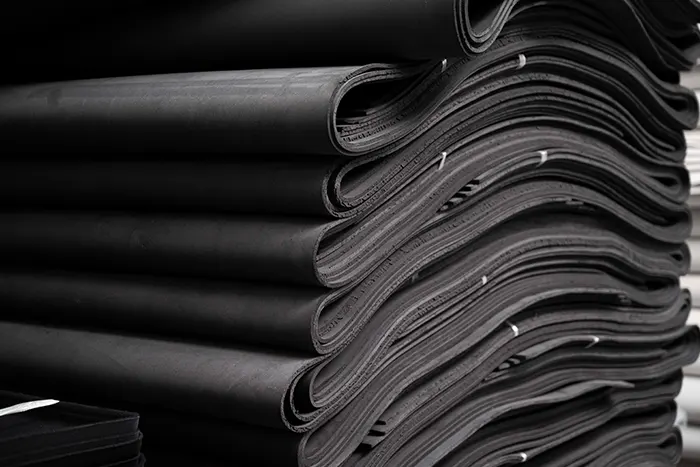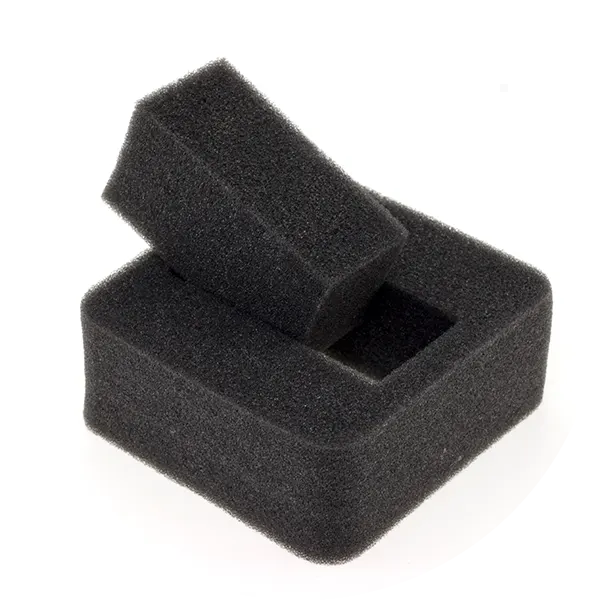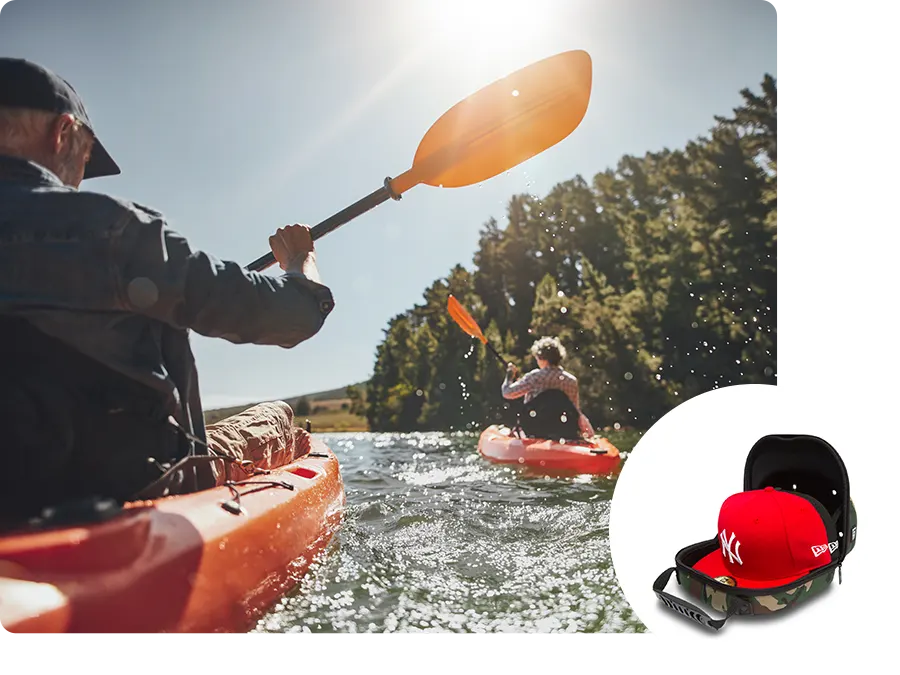Was ist EVA-Schaum??
Definition von EVA-Schaum
EVA-Schaum, kurz für Ethylen-Vinylacetat-Schaum, ist ein vielseitiges und weit verbreitetes Material in verschiedenen Branchen. Es ist eine Art geschlossener Zellschaum, der für seine Haltbarkeit bekannt ist, Flexibilität, und ausgezeichnete schockabsorbierende Eigenschaften.
EVA -Schaumstoffzusammensetzung und Herstellungsprozess

EVA -Schaum besteht aus Ethylen- und Vinylacetat -Copolymeren, die aus Petrochemikalien abgeleitet werden. Diese Copolymere werden in einer kontrollierten Umgebung zusammengemischt, wo ein Katalysator hinzugefügt wird, um den Polymerisationsprozess zu initiieren. Das resultierende Material wird dann erhitzt und unter Druck gesetzt, Sie dehnen sich aus und bilden einen Schaum mit versiegelten Zellen.
Während des Herstellungsprozesses, Verschiedene Additive wie Farbmittel, Flammschutzmittel, und Stabilisatoren sind integriert, um die spezifischen Eigenschaften des EVA -Schaums zu verbessern, wie UV -Widerstand und Flammenwiderstand. Der Grad des Vinylacetatgehalts im Copolymergemisch bestimmt die Eigenschaften des Schaumstoffs, wie seine Weichheit, Flexibilität, und Dichte.
Sobald der Schaum gebildet ist, Es kann geschnitten werden, geformt, und in verschiedenen Größen und Formen mit speziellen Maschinen geformt. Wärme und Druck können angewendet werden, um komplexe Muster zu erzeugen, Prägung, oder Texturen auf der Schaumstoffoberfläche. Mit dieser Vielseitigkeit im Fertigung kann EVA -Schaum gemäß den spezifischen Anforderungen für verschiedene Anwendungen angepasst werden.
Ist Eva Foam Gummi oder Plastik?

Viele Menschen fragen sich oft, ob EVA -Schaum als Gummi oder Plastik eingestuft wird. Während Eva Foam einige Eigenschaften sowohl mit Gummi als auch mit Kunststoff teilt, Es ist weder rein Gummi noch Kunststoff.
Eva Foam gegen Gummi
- Zusammensetzung: Während sowohl EVA -Schaum als auch Gummi flexible Materialien sind, Sie haben unterschiedliche chemische Zusammensetzungen. EVA-Schaum wird aus Ethylen-Vinylacetat-Copolymer hergestellt, ein synthetisches Material, das aus Erdöl stammt. Auf der anderen Seite, Gummi ist ein natürliches elastisches Material, das aus dem Saft von Gummibäumen oder synthetisch erzeugt wird.
- Dichte: EVA -Schaum ist im Allgemeinen weniger dicht als Gummi. Es hat eine zelluläre Struktur mit Lufttaschen, Machen Sie es leicht und Polsterung. Gummi, auf der anderen Seite, ist dichter und bietet ein höheres Maß an Haltbarkeit und Schlagfestigkeit.
- Härte: Der EVA -Schaum wird je nach gewünschter Anwendung in einer Reihe von Härtenoptionen ausgestattet. Es kann weich und biegsam oder fester sein, mit erhöhter Kompressionsstärke, Abhängig von der Menge an Vinylacetat, die in der Copolymerformulierung verwendet werden. Gummi, Jedoch, hat in der Regel eine höhere Härte auf der ganzen Linie.
Eva Foam gegen Plastik
- Flexibilität: EVA -Schaum ist flexibler als die meisten Kunststoffe. Es kann leicht gebogen werden, verdreht, oder komprimiert, ohne seine Form oder strukturelle Integrität zu verlieren. Kunststoff, Abhängig von ihrer Zusammensetzung, Kann unterschiedliche Flexibilitätsniveaus haben, sind aber oft starrer als EVA -Schaum.
- Aufprallabsorption: EVA-Schaum ist bekannt für seine hervorragenden Stoßdämpfungseigenschaften. Es kann wirksame Aufprallkräfte effektiv absorbieren und dispergieren, Es ist ideal für Anwendungen, die Dämpfung oder Schutz erfordern. Die meisten Kunststoffe, auf der anderen Seite, haben weniger Einflussabsorptionsfähigkeit.
- Wärmewiderstand: EVA -Schaum hat im Vergleich zu vielen Kunststoffen eine relativ geringe Wärmewiderstand. Bei höheren Temperaturen, EVA -Schaum kann deformieren oder schmelzen. Kunststoffmaterialien, Abhängig von ihrem Typ, kann einen größeren Bereich an Wärmefestigkeit aufweisen.
Unterschiede zwischen EVA -Schaum und anderen Schaumstoffmaterialien

EVA -Schaum gegen Polyethylenschaum
Polyethylenschaum ist ein häufig verwendetes Schaumstoffmaterial, das einige Ähnlichkeiten mit EVA -Schaum hat. Beide Materialien sind bekannt für ihre leichten und ausgezeichneten Stoßdämpfungseigenschaften.
Erstens, EVA -Schaum bietet eine höhere Haltbarkeit im Vergleich zu Polyethylenschaum. EVA -Schaum ist widerstandsfähiger gegen das Riss und kann starker Gebrauch standhalten, ohne seine Form zu verlieren. Auf der anderen Seite, während Polyethylenschaum noch langlebig ist, Es ist möglicherweise nicht so geeignet für Anwendungen, die langfristige Robustheit erfordern.
Zweitens, EVA -Schaum besitzt überlegene Vielseitigkeit Wenn es um die Anpassung geht. Es ist in verschiedenen Dichten erhältlich, Dicke, und Farben, die eine breitere Reihe von Anwendungen ermöglichen. Polyethylenschaum, auf der anderen Seite, hat im Allgemeinen nur begrenzte Optionen in Bezug auf die Anpassung.
EVA -Schaum gegen Neoprenschaum
Neoprenschaum ist eine Art Schaumstoffmaterial, das für seine bemerkenswerten Isolationseigenschaften bekannt ist. Im Gegensatz zu Eva Foam, Neoprenschaum besteht aus geschlossener Zellkonstruktion, Es ist eine ausgezeichnete Wahl für Anwendungen, die Isolierung gegen Temperatur oder Wasser erfordern.
Wenn es um Flexibilität geht, Neoprenschaum bietet mehr Elastizität im Vergleich zu EVA -Schaum. Dies macht es ideal für Anwendungen, bei denen der Schaum dehnen oder sich beugen muss, ohne seine Form oder Integrität zu verlieren. Im Gegensatz, Während Eva -Schaum noch einigermaßen flexibel ist, Es ist nicht so dehnbar wie Neoprenschaum.
Eva -Schaum gegen Speicherschaum
Speicherschaum, Auch als viskoelastischer Schaum bekannt, ist eine einzigartige Art von Schaum, der auf Wärme und Druck reagiert, Formen zur Form des Körpers. Im Gegensatz zu Eva Foam, Speicherschaum wird hauptsächlich für Komfort- und Dämpfungszwecke verwendet, vor allem in Bettwäsche- und Möbelindustrien.
Im Vergleich zu Gedächtnisschaum, Eva Foam hat eine festere und strengere Struktur. Es bietet hervorragende Unterstützung, Damit für Anwendungen geeignet sind, die Stabilität und Aufprallfestigkeit erfordern. Speicherschaum, auf der anderen Seite, ist bekannt für seine Weichheit und Fähigkeit, sich an Körperkonturen anzupassen.
Arten von EVA -Schaum

Standard EVA -Schaum
Standard -EVA -Schaum ist der am häufigsten verwendete Typ und für seine Vielseitigkeit bekannt. Es wird in Branchen wie Schuhen häufig eingesetzt, Sportgeräte, Verpackung, und sogar Automobil. Diese Art von Schaum bietet hervorragende Stoßdämpfung, Haltbarkeit, und Dämpfungseigenschaften. Es eignet sich perfekt für Anwendungen, bei denen die Aufprallfestigkeit und der Komfort unerlässlich sind. Standard -EVA -Schaum ist in verschiedenen Dicken erhältlich, Dichten, und Farben, Es ist eine beliebte Wahl für Industrie- und Handwerksprojekte zu einer beliebten Wahl.
Vernetzter EVA-Schaum
Cross-verknüpfter EVA-Schaum ist eine fortschrittlichere Version von Standard EVA-Schaum. Es wird während des Produktionsprozesses unter Verwendung eines Vernetzungsmittels hergestellt, Dies verbessert die Gesamtleistung des Materials. Diese Art von Schaum wird häufig in Anwendungen verwendet, die außergewöhnliche Festigkeit erfordern, chemischer Widerstand, und Wärmeisolierung. Cross-verknüpfter EVA-Schaum ist häufig in Gebieten wie Meeres- und Wassersportgeräten vorhanden, Schutzausrüstung, Orthopädische Klammern, und sogar medizinische Geräte. Seine überlegenen Eigenschaften machen es für anspruchsvolle Umgebungen sehr geeignet.
Erweiterter Eva -Schaum
Erweiterter Eva -Schaum, Auch als mikrozellulärer Schaum bekannt, verfügt über eine feinere Zellstruktur im Vergleich zu Standard -EVA -Schaum. Diese Art von Schaum ist ein gleichmäßigeres Aussehen mit winzigen geschlossenen Zellen, es fester und dichter machen. Der erweiterte EVA -Schaum bietet eine ausgezeichnete dimensionale Stabilität, Auftrieb, und Isolationseigenschaften. Es findet Anwendungen in Bereichen wie Wassersportzubehör, Flotationsgeräte, und Dichtungen. Zusätzlich, Seine glatte und sogar Oberfläche macht es Eine bevorzugte Wahl zum Drucken und Laminieren.
Eigenschaften von EVA -Schaum

Leicht und langlebig
Einer der wichtigsten Vorteile von EVA -Schaum ist die leichte Natur. Dies macht es in Anwendungen, bei denen Gewicht ein Problem darstellt, wie in der Herstellung von Schuhen und Rucksäcken. Obwohl es leicht ist, EVA -Schaum zeigt auch eine beeindruckende Haltbarkeit, Stellen Sie sicher, dass es regelmäßigen Verschleiß standhalten kann, ohne seine strukturelle Integrität zu verlieren.
Weich, Dämpfungseffekt
Eva Foam ist bekannt für seine weiche und Polsterwirkung. Es ist sehr vorteilhaft für Produkte, die für den Komfort ausgelegt sind, wie Schuheinlegesole und kniende Pads. Die Fähigkeit des Schaumstoffs, den Scherz angemessen aufzunehmen und Druck gleichmäßig zu verteilen, Es ist ideal für Aktivitäten, die lange Stehen oder Auswirkungen beinhalten, Wie Sportveranstaltungen.
Wasser- und Feuchtigkeitsbeständigkeit
Eine weitere bemerkenswerte Eigenschaft von EVA -Schaum ist sein Wasser- und Feuchtigkeitsbeständigkeit. Dieses Merkmal macht es für Anwendungen, bei denen die Exposition gegenüber Wasser oder Feuchtigkeit unvermeidlich ist, wie im Schwimmbad schwimmend oder Meeresumgebungen. EVA Foam -Widerstand gegen Wasseraufnahme verhindert den Abbau, Stellen Sie sicher, dass es auch unter feuchten Bedingungen seine Qualität und Funktionalität aufrechterhalten kann.
Wärmeisolierung
EVA -Schaum zeigt hervorragende Wärmeisolationseigenschaften, Es ist eine attraktive Wahl für Anwendungen, die eine Temperaturregulierung erfordern. Die isolierende Natur ermöglicht es ihnen, Wärme zu behalten, Machen Sie es nützlich in Produkten wie Thermisisolationsauskleidungen in Schuhen oder Isolationskomponenten in der Verpackung. Diese Eigenschaft ist besonders vorteilhaft, um optimale Temperaturen aufrechtzuerhalten und vor extremen heißen oder kalten Bedingungen zu schützen.
Chemische und UV -Resistenz
Schließlich, EVA -Schaum besitzt eine beeindruckende Resistenz gegen Chemikalien und UV -Strahlung. Dieser Widerstand macht es für Anwendungen geeignet, bei denen harte Chemikalien oder Sonnenlicht ausgesetzt sind, wie Gartenknien oder Außenmatten. Die Fähigkeit von EVA Foam, der chemischen Korrosion und dem Abbau von UV standzuhalten.
Anwendungen von EVA -Schaum

Sport und Erholung
Eine herausragende Anwendung von EVA -Schaum in diesem Sektor ist in sportliche Schuh -Halbfälle. Der Schaum bietet die notwendige Unterstützung und Komfort, die Sportler benötigen, Verringerung des Verletzungsrisikos.
Zusätzlich, EVA -Schaum wird häufig bei der Herstellung von verwendet Yogamatten und Trainingsgeräte. Die weiche und flexible Natur des Schaums sorgt für ein komfortables Trainingserlebnis und bietet gleichzeitig Griff und Stabilität.

Verpackung und Transport
Die Fähigkeit von EVA Foam, empfindliche Gegenstände zu schützen, macht es zu einem idealen Material für Verpackungs- und Transportzwecke. EVA -Fälle und EVA -Schaumfall -Beilagen werden häufig verwendet, um fragile Waren während des Transports zu schützen. Die Schaumstoffeinsätze bieten Polster- und Stoßdämpfereigenschaften, Schäden durch Aufprall oder Vibration verhindern.

Cosplay und Requisiten
Eva Foam hat unter Cosplayern und Prop -Herstellern aufgrund seiner Vielseitigkeit und Leichtigkeit der Manipulation an Popularität gewonnen. Der Schaum kann leicht geformt werden, geformt, und gemalt zu Erstellen Sie aufwändige Rüstungsstücke und Kostüme für Cosplaying -Events. Die leichte Natur stellt sicher, dass der Träger die aufwändigen Outfits bequem anziehen kann.
Darüber hinaus, EVA -Schaum wird ausführlich in der Schaffung von Bühnen- und Film -Requisiten eingesetzt. Seine Fähigkeit, verschiedene Texturen und Oberflächen nachzuahmen, kombiniert mit seiner Haltbarkeit, macht es zu einer bevorzugten Wahl für Propeldesigner. Von komplizierten Waffen bis zu realistischen Versatzstücken, EVA Foam ermöglicht die Schaffung visuell faszinierender Szenen in der Unterhaltungsindustrie.
Dies sind nur einige Beispiele für die zahlreichen Anwendungen von EVA -Schaum in verschiedenen Branchen. Seine Vielseitigkeit, Haltbarkeit, und Kosteneffizienz machen es zu einem Anlaufmaterial für Hersteller, Kreative, und Athleten gleichermaßen.
Vor- und Nachteile von EVA -Schaum
Vorteile von EVA -Schaum
Vielseitigkeit und Flexibilität: Es ist in verschiedenen Dichten erhältlich, Dicke, und Farben, wodurch es für ein breites Anwendungsspektrum geeignet ist. EVA -Schaum kann leicht geformt werden, geformt, und in verschiedene Formen geschnitten. Seine Flexibilität macht es zu einem idealen Material, um komfortable und gepolsterte Produkte zu schaffen.
Leichte Handhabung und Anpassung: EVA -Schaum ist aufgrund seiner leichten und biegsamen Natur außergewöhnlich einfach zu handhaben. Dies macht es bequem, zu manipulieren und zu arbeiten, Damit sowohl für die großflächigen Fertigung als auch für DIY-Projekte geeignet sind. Zusätzlich, EVA -Schaum kann leicht angepasst werden, um bestimmte Designanforderungen zu erfüllen. Es kann gemalt werden, geklebt, hitziger Versiegelung, oder sogar sterben, ohne seine ursprünglichen Eigenschaften zu verlieren.
Nachteile von EVA -Schaum
Begrenzte Resistenz gegen extreme Temperaturen: Während EVA -Schaum bis zu einem bestimmten Temperaturbereich Wärmefestigkeit aufweist, Es ist nicht für den Einsatz bei extremen Hitze oder kalten Bedingungen geeignet. Hohe Temperaturen können dazu führen, dass sich der Schaum verformt, schmelzen, oder auch Giftige Dämpfe ausgeben. Ähnlich, Die Exposition gegenüber extrem kalten Temperaturen kann zu einem spröden und steifen Schaum führen, Reduzierung der Gesamtwirksamkeit.
Nicht geeignet für tragende Anwendungen: EVA-Schaum ist nicht für tragende Anwendungen geeignet. Es fehlt die notwendige Stärke und strukturelle Integrität für den strengen Gebrauch. Es kann unter erheblichem Druck komprimieren oder verformen, Für Anwendungen, die tragende Funktionen erfordern, wie Bauwesen oder industrielle Nutzung.
Sicherheitsüberlegungen mit EVA -Schaum
Gesundheitsgefahren und Vorsichtsmaßnahmen
- Inhalationsrisiken: Beim Schneiden oder Gestalten von EVA -Schaum, Partikel und Staub können in die Luft freigesetzt werden. Es ist wichtig, in einem gut belüfteten Bereich zu arbeiten oder eine Maske zu tragen, um das Einatmen dieser Partikel zu verhindern.
- Hautempfindlichkeit: Einige Personen können bei Kontakt mit EVA -Schaum. Es wird empfohlen, Handschuhe und Schutzkleidung zu tragen, Besonders für diejenigen, die empfindliche Haut oder eine Vorgeschichte allergischer Reaktionen haben.
Brandschutz und Entflammbarkeit
- Entflammbarkeit: EVA -Schaum ist ein brennbares Material und kann sich leicht entzünden. Es ist wichtig, es von offenen Flammen fernzuhalten, Funken, oder hohe Wärmequellen, um Brandgefahren zu vermeiden. Arbeiten Sie immer in einem gut belüfteten Gebiet, um das Brandrisiko zu minimieren.
- Feuerschutzmittel: Einige Hersteller bieten feuerpolsamen EVA-Schaum an, die mit flammhemmenden Chemikalien behandelt wurde, um seine Entflammbarkeit zu verringern. Wenn Brandschutz ein Anliegen ist, Es ist ratsam, Feuer-Retardant EVA Foam-Produkte zu wählen.
Entsorgung und Umweltauswirkungen

- Recycling: EVA -Schaum wird von regelmäßigen Recyclingprogrammen nicht weit verbreitet. Jedoch, Einige spezialisierte Recyclingzentren oder Organisationen können dies akzeptieren.
- Umweltauswirkungen: EVA -Schaum ist nicht biologisch abbaubar und kann lange Zeit auf Deponien bestehen, Beitrag zur Umweltverschmutzung.
Wartung und Pflege von EVA -Schaumprodukten
Reinigen Sie Eva -Schaum
Um Ihre EVA -Schaumprodukte in Top -Zustand zu halten, Regelmäßige Reinigung ist unerlässlich. Anfangen vorbei Entfernen Sie losen Schmutz oder Staub mit einer weichen Bürste oder einem Tuch. Für hartnäckigere Flecken, Mischen Sie ein mildes Waschmittel mit warmem Wasser und schrubben Sie den betroffenen Bereich vorsichtig mit einem Schwamm oder Tuch. Vermeiden Sie es, harte Chemikalien oder Schleifreiniger zu verwenden, da sie den Schaum beschädigen können. Einmal gereinigt, Abspülen Sie alle Seifenreste gründlich mit sauberem Wasser und lassen Sie den Schaum Luft trocken vollständig Vor dem Verwenden oder Speichern.
Beschädigung und Verschlechterung verhindern
Vermeiden Sie es, schwere Gegenstände auf den Schaum zu legen, da es dauerhafte Eindrücke verursachen kann. Halten Sie den Schaum von scharfen Gegenständen oder rauen Oberflächen fern Das kann Schnitte oder Tränen verursachen. Es wird auch empfohlen zu Vermeiden Sie es, den Schaum einem verlängerten direkten Sonnenlicht oder hohen Temperaturen auszusetzen, Da kann dies zu Verblassen und Verschlechterung führen. Zusätzlich, vermeiden Verwenden des Schaums in Bereichen mit übermäßiger Feuchtigkeit oder Luftfeuchtigkeit Um Schimmel oder Mehltauwachstum zu verhindern.
Langzeitlagerung
Beginnen Sie damit, sicherzustellen, dass der Schaum vor dem Speichern trocken und sauber ist. Vermeiden Sie das Falten oder Falten des Schaums, da dies dauerhafte Schäden verursachen kann. Stattdessen, Lagern Sie den Schaum in einem Cool, trocken, und gut belüfteter Bereich, in dem es vor direktem Sonnenlicht geschützt ist. Wenn möglich, Legen Sie den Schaum in eine versiegelte Plastiktüte oder einen Behälter, um Staub vorzubeugen, Schmutz, oder potenzielle Feuchtigkeit davon.
FAQ auf EVA -Schaum
Kann Eva -Schaum gestrichen werden??
Einer der großen Vorteile von EVA -Schaum ist seine Lackierbarkeit. Egal, ob Sie ein realistisches Finish für Ihre Cosplay -Rüstung erzielen oder einem Handwerksprojekt lebhafte Farben verleihen möchten, Eva -Schaum akzeptiert leicht verschiedene Arten von Farben, einschließlich Acryl, Latex, und Sprühfarben. Bevor ich anfing zu malen, Es wird empfohlen, die Oberfläche des Schaums mit Alkohol oder einem sanften Reinigungsmittel zu reinigen, um Schmutz oder Öle zu entfernen.
Kann Eva-Schaum hitziggemacht werden??
Ja, EVA-Schaum kann hitzebildet werden, Dies ist eine Technik, die häufig verwendet wird, um komplizierte Formen und 3D -Formen zu erstellen. Wärme-, Machen Sie es geschmeidig und lassen Sie es umgestaltet werden. Dieser Prozess ist besonders nützlich bei der Herstellung von Cosplay -Requisiten oder bei der Gestaltung ergonomischer Schaumstoffprodukte. Eva-Schaum zu heizen, Sie können verschiedene Methoden anwenden, wie die Verwendung einer Heißluftpistole, heißes Wasser, oder ein Ofen. Einmal erhitzt, Der Schaum kann von Hand geformt werden oder verwenden Formen/Werkzeuge, um komplizierte Details zu erhalten. Es ist wichtig zu beachten, dass nach Wärme- molding, Der Schaum kann seine neue Form behalten, Oder Sie müssen es mit zusätzlichen Schichten oder strukturellen Stützen für Langlebigkeit und Stabilität verstärken.
Kann Eva -Schaum recycelt werden??
Während das Recycling von EVA -Schaum einige Herausforderungen darstellt, Es ist nicht ganz unmöglich. Aufgrund des Vorhandenseins verschiedener Additive und der zusammengesetzten Natur des Schaums, Die Recyclingoptionen können begrenzt sein. Jedoch, Einige Einrichtungen sind auf das Recycling von EVA -Schaum spezialisiert und können ihn in neue Produkte verarbeiten oder in verwendbare Rohstoffe umwandeln. Es wird empfohlen, nach lokalen Recyclingzentren oder speziellen Einrichtungen zu suchen, die EVA -Schaum akzeptieren. Zusätzlich, Erwägen Sie, Schaumstoffabfälle für kleinere Projekte wiederzuverwenden oder umzusetzen, um Abfall zu minimieren. Mit zunehmendem Bewusstsein für nachhaltige Praktiken steigt, Es werden Anstrengungen unternommen, um effizientere Wege zu untersuchen, um EVA -Schaum zu recyceln, Verbesserung der Umweltfreundlichkeit in der Zukunft.
Abschluss
EVA Foam bietet immens im Bereich der immensen Möglichkeiten in verschiedenen Bereichen, und seine Eigenschaften verstehen, wie seine Lackierbarkeit, Wärmemoldpotential, und Recyclingoptionen, ist unerlässlich, um den Nutzen zu maximieren. Ob Sie ein Cosplayer sind, Handwerker, oder umweltbewusster Schöpfer, Die Vielseitigkeit und Anpassungsfähigkeit von EVA Foam machen es zu einem bemerkenswerten Material, mit dem man arbeiten kann.
















